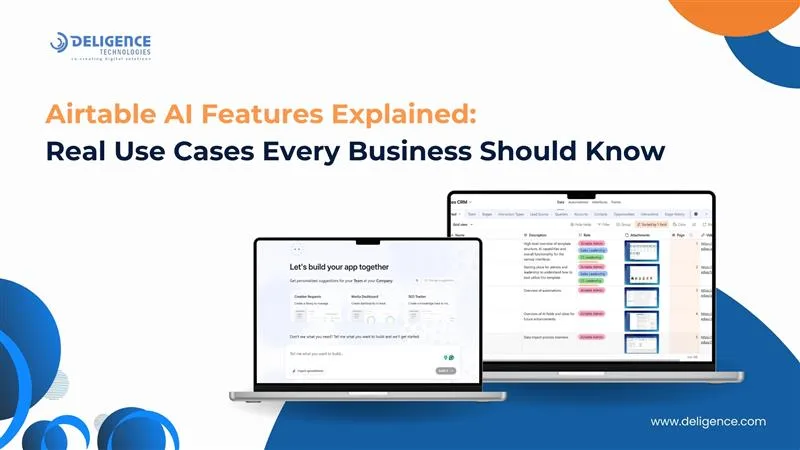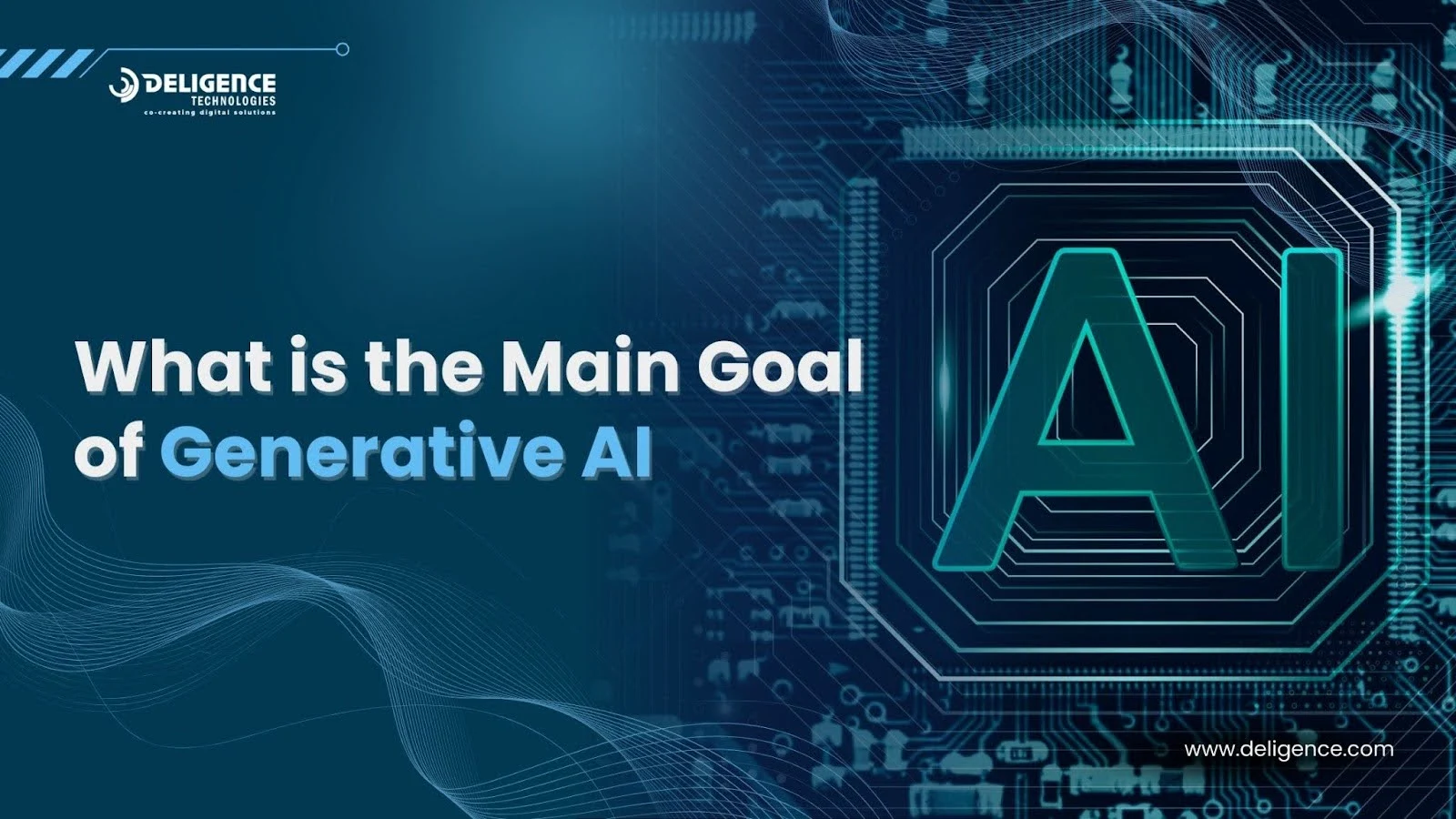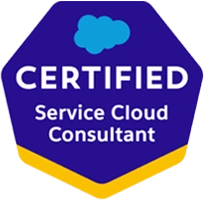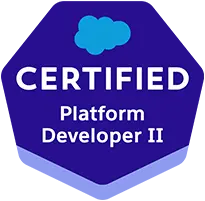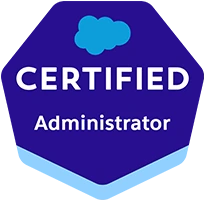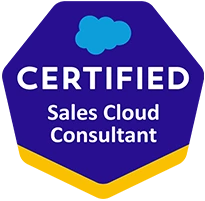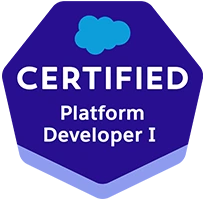Complete Guide to Airtable AI Integration for Business Automation in 2025
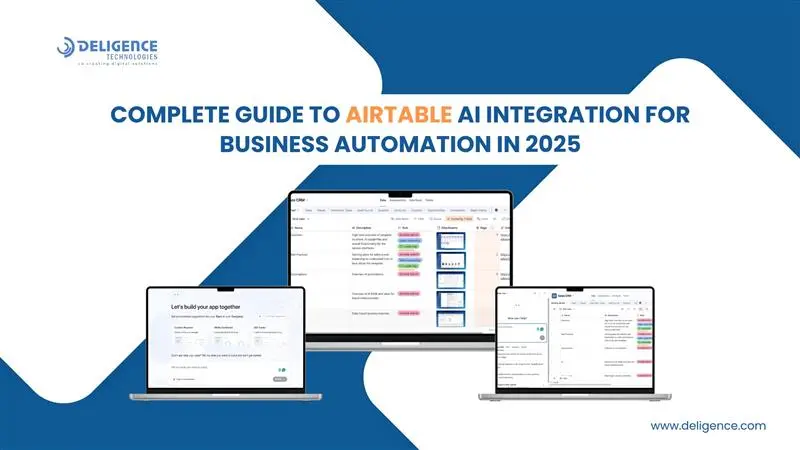
Summary
- Airtable is now AI-nativeIt’s no longer just a spreadsheet-database combo—it’s a powerful AI automation platform that can build entire business systems for you.
- AI Automation is taking over (in a good way!) Businesses are building smarter systems faster and cheaper, without needing developers. Teams stay lean, productive, and focused on high-value work.
- Meet Omni, your AI assistant Omni can build workflows, automate tasks, and even design project systems just by chatting with you. It’s like having an AI software developer on your team.
- Smart Fields do the thinking These AI-powered fields can categorize emails, score leads, predict revenue, analyze feedback, and more—automatically.
- Connect with powerful tools like ChatGPT, Zapier, Make, and Power Automate Airtable plays well with other AI tools, letting you create insanely powerful workflows without code.
- Start using AI on any plan—even free! Airtable gives every user AI access with credits based on their plan. No special software or setup needed—just your browser.
The future belongs to businesses that use AI as an assistant, not a replacement. And with Airtable, you’ve got the tools to start now—even if you’re not a tech expert.
Table of Contents
1. Introduction: Airtable AI Integration
- What is Airtable?
- What is Airtable AI Integration?
- Why Everyone’s Talking About AI Automation Right Now
- The Big Three Benefits You’ll Actually Notice
2. What Can Airtable AI Integration Actually Do?
- Meet Omni: Your New AI Assistant
- Smart Fields That Think for Themselves
- Connecting to Other AI Tools
- How This is Different from Old-School Automation
3. What You Need to Get Started
- Which Airtable Plan Do You Need?
- Technical Requirements (Don’t Worry, It’s Simple)
- Setting Up Your Team
- How Much Will This Cost You?
4. Ways to Integrate AI Into Your Business Using Airtable
- Having Conversations with Omni
- Smart Data Organization
- AI-Powered Validation
- Connecting Airtable with No-Code Tools
- Customer Relationship Management
- Marketing and Content
- Project Management
6. Keeping Your Data Safe and Secure
- Privacy and Data Protection
- Following the Rules (Compliance)
- Access Control and Monitoring
1. Introduction: Airtable AI Integration
The landscape of business automation has undergone a seismic shift in 2025, with artificial intelligence transforming how organizations manage data, streamline workflows, and make strategic decisions. At the forefront of this revolution stands Airtable, which has evolved from a simple database tool into a comprehensive AI-native platform that enables businesses to build sophisticated automation systems without requiring extensive coding expertise.
What is Airtable?
Airtable is a cloud-based platform that combines the functionality of a spreadsheet with the power of a database. It’s designed to help individuals and teams organize, track, and collaborate on various types of information and projects.
What is Airtable AI Integration?
Airtable AI integration services represent the convergence of structured data management with intelligent automation capabilities. Unlike traditional database systems that merely store and retrieve information, Airtable’s AI-powered platform can understand context, generate insights, and execute complex decision-making processes automatically. This integration encompasses three primary components:
Native AI Features: Built-in tools like AI fields, automated data processing, and intelligent suggestions that work directly within the Airtable environment.
Third-Party AI Integrations: Connections to external AI services such as OpenAI, Google AI, and Microsoft Cognitive Services that extend Airtable’s capabilities.
Workflow Automation: Intelligent automation sequences that can trigger actions, process data, and make decisions based on predefined rules and AI-driven insights.
Why Everyone’s Talking About AI Automation Right Now
We’re in the middle of a huge shift in how businesses work. Companies are realizing they don’t need to hire expensive programmers or wait months for custom software. With tools like Airtable AI, you can build powerful business systems in hours, not months.
The best part? You’re not replacing humans – you’re making them more productive. Instead of spending hours on boring, repetitive tasks, your team can focus on creative work, building relationships, and growing the business.
The Big Three Benefits You’ll Actually Notice
You’ll Save Tons of Time: Imagine cutting your data entry time by 70%. That’s what most businesses see when they start using Airtable AI. Tasks that used to take hours now happen automatically.
You’ll Save Money: No more expensive software developers or complex IT projects. One person with Airtable AI can often do what used to require a whole team.
You Can Grow Without Growing Pains: As your business gets bigger, your AI systems can handle more work without you needing to hire more people. It’s like having a team that can magically multiply when you need it.
2. What Can Airtable AI Integration Actually Do?
Meet Omni: Your New AI Assistant
Omni is Airtable’s AI brain, and it’s honestly pretty amazing. You can have a conversation with it just like you would with a human assistant. Here’s what makes it special:
You can say things like “I need a system to track customer complaints and automatically assign them to the right team member.” Omni will build that entire system for you – tables, forms, automation, the works. It’s like having a personal software developer who works instantly.
What Omni Can Build for You:
- Customer databases that automatically organize information
- Project management systems that track deadlines and assign tasks
- Marketing campaigns that run themselves
- Sales pipelines that predict which deals will close
- Inventory systems that reorder products automatically
Smart Fields That Think for Themselves
These are probably the coolest features. Smart fields can read your data and make decisions about it. For example, if you have customer feedback coming in, a smart field can automatically figure out if customers are happy or upset, and even suggest what to do about it.
Real Examples:
- A field that reads emails and automatically categorizes them
- A field that looks at sales data and predicts next month’s revenue
- A field that reads job applications and scores candidates
- A field that analyzes social media posts and suggests responses
Connecting to Other AI Tools
While Airtable’s built-in AI is powerful, sometimes you need something more specialized. The good news is that Airtable plays well with other AI tools. You can connect it to ChatGPT for better writing, or to image recognition tools for processing photos, or to specialized industry tools for specific tasks.
How This is Different from Old-School Automation
Traditional automation was like programming a robot – you had to think of every possible scenario and write specific rules for each one. If something unexpected happened, the system would break.
Airtable AI Integration is more like training a smart employee. It learns from your data, adapts to new situations, and can make decisions on its own. If something unexpected happens, it figures out what to do based on what it has learned.
2. What Can Airtable AI Integration Actually Do?
Meet Omni: Your New AI Assistant
Omni is Airtable’s AI brain, and it’s honestly pretty amazing. You can have a conversation with it just like you would with a human assistant. Here’s what makes it special:
You can say things like “I need a system to track customer complaints and automatically assign them to the right team member.” Omni will build that entire system for you – tables, forms, automation, the works. It’s like having a personal software developer who works instantly.
What Omni Can Build for You:
- Customer databases that automatically organize information
- Project management systems that track deadlines and assign tasks
- Marketing campaigns that run themselves
- Sales pipelines that predict which deals will close
- Inventory systems that reorder products automatically
Smart Fields That Think for Themselves
These are probably the coolest features. Smart fields can read your data and make decisions about it. For example, if you have customer feedback coming in, a smart field can automatically figure out if customers are happy or upset, and even suggest what to do about it.
Real Examples:
- A field that reads emails and automatically categorizes them
- A field that looks at sales data and predicts next month’s revenue
- A field that reads job applications and scores candidates
- A field that analyzes social media posts and suggests responses
Connecting to Other AI Tools
While Airtable’s built-in AI is powerful, sometimes you need something more specialized. The good news is that Airtable plays well with other AI tools. You can connect it to ChatGPT for better writing, or to image recognition tools for processing photos, or to specialized industry tools for specific tasks.
How This is Different from Old-School Automation
Traditional automation was like programming a robot – you had to think of every possible scenario and write specific rules for each one. If something unexpected happened, the system would break.
Airtable AI Integration is more like training a smart employee. It learns from your data, adapts to new situations, and can make decisions on its own. If something unexpected happens, it figures out what to do based on what it has learned.
3. What You Need to Get Started
Which Airtable Plan Do You Need?
Here’s some great news – you can start using Airtable AI even on the free plan. Yes, really! Airtable made AI available to everyone, though you’ll get different amounts of AI “credits” depending on your plan.
Free Plan: Perfect for testing things out. You get basic AI features with enough credits to try different automations and see what works for your business.
Team Plan: Great for small businesses. You get more AI credits (about 7,500 per user during trials) and can build more complex systems.
Business Plan: For growing companies that need more AI power and faster processing.
Enterprise Plan: Unlimited AI usage with extra security features for big companies.
Technical Requirements (Don’t Worry, It’s Simple)
The best part about Airtable AI Integration is that you don’t need any special software or technical setup. It all works in your web browser. If you can use Google or Facebook, you can use Airtable AI.
What You Need:
- A modern web browser (Chrome, Firefox, Safari, or Edge)
- An internet connection
- That’s it!
Setting Up Your Team
Different people on your team will have different levels of access to AI features:
Creators: Can build new AI systems and automations Editors: Can use AI features but can’t create new ones Viewers: Can see AI-generated content but can’t change anything
The person who owns your Airtable workspace can control who gets access to what. For most small businesses, you’ll probably want to give creator access to a few key people and editor access to everyone else.
How Much Will This Cost You?
Airtable AI uses a “credit” system. Think of credits like tokens at an arcade – different AI tasks cost different amounts of credits. Simple tasks like generating a short email might cost 1-2 credits, while complex analysis might cost 10-50 credits.
Each plan comes with monthly credits that reset every month. If you use them all up, you can buy more. Most small businesses find that the included credits are more than enough to get started.
Money-Saving Tips:
- Start with simple automations and build up gradually
- Focus on high-impact tasks first
- Train your team to use AI efficiently
- Monitor your credit usage to avoid surprises
4. Ways to Integrate AI Into Your Business Using Airtable
Having Conversations with Omni
This is where the magic happens. You can literally talk to Omni like you’re talking to a helpful coworker. Here’s how to get the best results:
Good Way to Ask: “I need a system to track customer orders. When someone places an order, I want to automatically send them a confirmation email, update our inventory, and create a task for the shipping team.”
Not So Good: “Make me a database.”
The more specific you are, the better Omni can help you. Think of it like explaining what you need to a new employee – give context, explain the goal, and mention any special requirements.
Smart Data Organization
One of the most immediately useful features is having AI automatically organize your data. Instead of manually sorting through hundreds of customer emails, AI can instantly categorize them, identify urgent issues, and even suggest responses.
Real-World Example: A small e-commerce business uses AI to automatically:
- Sort customer emails by type (complaint, question, compliment)
- Identify urgent issues that need immediate attention
- Generate draft responses for common questions
- Update customer records with interaction history
AI-Powered Validation
AI can catch mistakes before they become problems. It can spot duplicate entries, fix formatting issues, and even notice when something seems off about your data.
What It Catches:
- Duplicate customer records
- Inconsistent formatting (like phone numbers)
- Missing important information
- Unusual patterns that might indicate errors
Connecting Airtable with No-Code Tools
Zapier Integration
Zapier is like a digital connector that can link Airtable to thousands of other apps. When you add AI into the mix, you can create incredibly powerful automated workflows.
Example Workflow: When someone fills out a contact form on your website, Zapier can:
- Add their information to Airtable
- Use AI to score how likely they are to become a customer
- Automatically send a personalized follow-up email
- Create a task for your sales team if they’re a high-value lead
- Add them to the right email marketing list
Make for Complex Automation
Make (formerly Integromat) is perfect when you need more complex automation. It has a visual workflow builder that lets you create sophisticated processes without any coding.
Advanced Example: A marketing agency uses Make to:
- Monitor social media mentions of their clients
- Use AI to analyze the sentiment of each mention
- Automatically respond to positive mentions with thanks
- Alert the team about negative mentions that need attention
- Generate weekly reports on social media performance
Microsoft Power Automate
If your business already uses Microsoft 365, Power Automate can connect Airtable AI to all your Microsoft tools.
Business Integration: When a new project is created in Airtable:
- Automatically create a Teams channel for the project
- Generate a project timeline in Project
- Create a shared folder in SharePoint
- Send calendar invites to team members
- Set up recurring status update reminders
5. Real Business Applications
Customer Relationship Management
Smart Lead Scoring
Instead of guessing which potential customers are worth your time, AI can analyze patterns in your data to predict who’s most likely to buy.
How It Works: AI looks at factors like:
- How they found you
- What pages they visited on your website
- How they responded to emails
- Their company size and industry
- Similar customers who became buyers
Then it gives each lead a score, so your sales team knows exactly who to call first.
Real Results: Most businesses see their sales teams close 30-40% more deals because they’re focusing on the right prospects.
Automated Follow-ups That Feel Personal
AI can write personalized follow-up emails that don’t sound robotic. It looks at each person’s specific situation and crafts messages that feel like they were written just for them.
What Makes It Special:
- Uses the person’s name and company details naturally
- References their specific interests or challenges
- Adjusts the tone based on their communication style
- Knows when to follow up based on their behavior
Understanding Customer Feedback
When you get hundreds of customer reviews, emails, or survey responses, AI can quickly tell you:
- What customers love about your business
- What’s frustrating them
- Which issues are most urgent
- How your customer satisfaction is trending over time
Marketing and Content
Creating Content at Scale
AI can help you create blog posts, social media content, product descriptions, and email campaigns. The key is giving it good instructions and then editing the results to match your brand voice.
Content Types It Handles Well:
- Product descriptions for e-commerce
- Blog post outlines and drafts
- Social media posts and captions
- Email newsletter content
- Basic ad copy
Pro Tip: AI is great at creating first drafts, but you’ll always want to review and personalize the content before publishing.
Social Media Management
AI can analyze when your audience is most active, what type of content performs best, and even suggest hashtags and captions for your posts.
Smart Scheduling: Instead of posting at random times, AI figures out exactly when your audience is most likely to see and engage with your content.
Content Optimization: AI can suggest tweaks to your posts to make them more engaging, like adjusting the caption length or recommending better hashtags.
Email Campaign Personalization
Gone are the days of sending the same email to everyone. AI can create unique email experiences for each person on your list.
Personalization Beyond Names:
- Different product recommendations based on past purchases
- Customized subject lines that match each person’s interests
- Optimal send times for each individual
- Content that matches their stage in the customer journey
Project Management
Smart Task Assignment
AI can look at your team’s workload, skills, and availability to suggest the best person for each task. It’s like having a project manager who never forgets anyone’s strengths or current workload.
Factors AI Considers:
- Who has the right skills for the task
- Current workload and availability
- Past performance on similar tasks
- Team dynamics and collaboration patterns
Predicting Project Success
By analyzing historical project data, AI can warn you about potential delays or budget overruns before they happen.
Early Warning System: AI might notice patterns like:
- Projects similar to yours that went over budget
- Team members who are overloaded and might miss deadlines
- Dependencies that could cause delays
- Scope creep that’s starting to happen
Resource Planning
AI can help you plan resource allocation across multiple projects, ensuring you’re not overcommitting your team or leaving anyone idle.
6. Keeping Your Data Safe and Secure
Privacy and Data Protection
When you’re using AI with your business data, security becomes extra important. Airtable takes this seriously and has built in strong protections.
How Your Data is Protected:
- Everything is encrypted when it’s stored and when it’s being processed
- You control who can access AI features in your workspace
- You can see exactly what data AI is using and how
- You can delete data and AI processing history anytime
Best Practices for Your Business:
- Only give AI access to people who need it
- Regularly review who has access to what
- Train your team on safe AI usage
- Keep sensitive data in separate, more restricted areas
Following the Rules (Compliance)
Different industries have different rules about data handling. Airtable is designed to help you follow these rules while still getting the benefits of AI.
For European Businesses (GDPR):
- You can opt out of AI processing entirely if needed
- Clear controls for user consent and data deletion
- Detailed logs of all AI processing activities
- Data stays in approved locations
For Other Industries:
- Healthcare: HIPAA compliance features
- Financial: Banking regulation compliance
- Legal: Attorney-client privilege protection
- Education: Student data protection
Access Control and Monitoring
You can control exactly who can use AI features and monitor how they’re being used.
Control Options:
- Turn AI features on or off for specific team members
- Set limits on AI usage for different users
- Monitor AI activity and usage patterns
- Get alerts for unusual AI usage
Monitoring Benefits:
- See which AI features are most valuable
- Identify training needs for your team
- Catch potential security issues early
- Track return on investment for AI features
7. What’s Coming Next
The AI revolution is moving fast, and Airtable is positioning itself at the forefront of this transformation. Airtable has recently relaunched as the AI-native app platform, where vibe coding meets enterprise reliability and the scalability of AI agents. Here’s what the future holds for businesses using Airtable AI.
What Airtable is Working On
Based on user feedback and industry trends, Airtable is likely working on:
- More natural language capabilities (talking to your database like a person)
- Better custom AI training with your specific data
- More sophisticated workflow automation
- Enhanced mobile AI capabilities
- Better integration with industry-specific tools
8. Key Success Factors
Based on thousands of businesses that have successfully integrated AI into their workflows using Airtable, here are the most important factors:
Start Small, Think Big: Begin with one simple automation and gradually expand. Don’t try to automate everything at once.
Focus on Pain Points: Choose AI applications that solve real problems your team faces every day.
Invest in Training: Make sure your team knows how to use AI features effectively. The technology is only as good as the people using it.
Keep Data Clean: AI works best with good data. Spend time organizing your information before diving into complex automations.
Monitor and Adjust: Regularly check how your AI systems are performing and make improvements.
Starting Points for Different Business Sizes
Small Business (Under 50 People):
- Start with basic AI fields for customer management
- Use Omni to create simple tracking systems
- Focus on automating repetitive tasks first
- Try one marketing automation workflow
- Keep it simple and build gradually
Medium Business (50-500 People):
- Implement department-specific AI solutions
- Connect Airtable to your existing tools with Zapier
- Create cross-departmental automation workflows
- Set up governance policies for AI usage
- Train champions in each department
Large Business (500+ People):
- Build company-wide AI strategy using Airtable’s enterprise features across all departments
- Connect Airtable AI to your existing business systems and data warehouses
- Set up AI expert teams to create templates and best practices for the whole company
- Use Airtable’s advanced security settings to keep data safe and follow industry rules
- Work with Airtable to build custom AI tools designed specifically for your business needs
9. Conclusion
The world of business is changing fast, and AI is at the center of that change. The good news is that tools like Airtable make this powerful technology accessible to everyone, not just big corporations with huge IT budgets.
You don’t need to be a tech expert to start benefiting from AI. You just need to be willing to experiment, learn, and gradually build better systems for your business.
The businesses that thrive in the next few years will be those that embrace AI not as a replacement for human creativity and judgment, but as a powerful tool that amplifies what humans do best. With Airtable AI Integration, you have everything you need to join that successful group.

